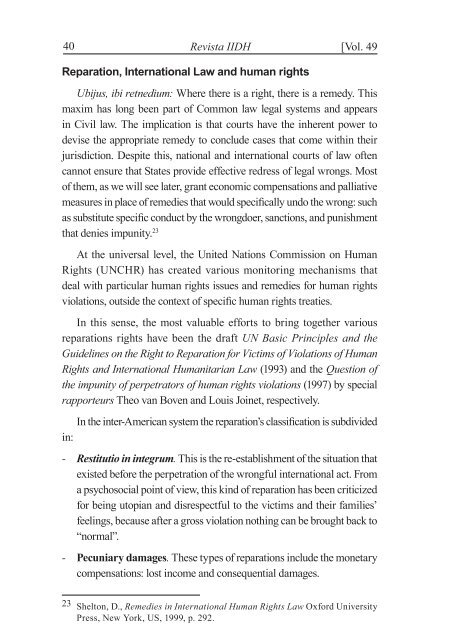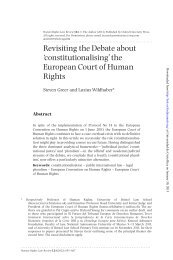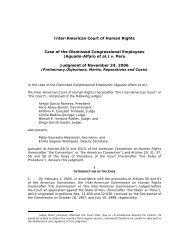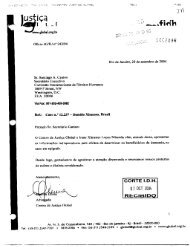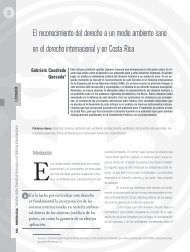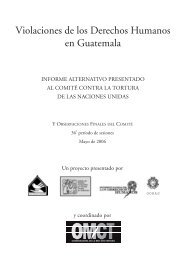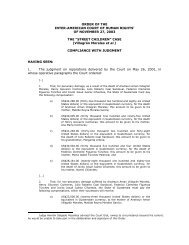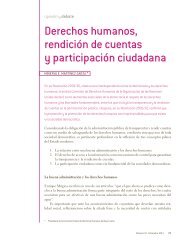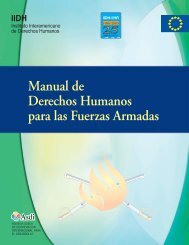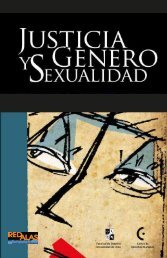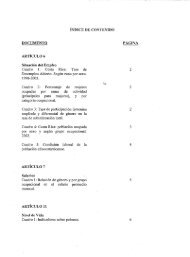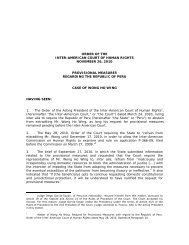Inter-American Court of Human Rights' reparation judgments ...
Inter-American Court of Human Rights' reparation judgments ...
Inter-American Court of Human Rights' reparation judgments ...
- No tags were found...
Create successful ePaper yourself
Turn your PDF publications into a flip-book with our unique Google optimized e-Paper software.
40 Revista IIDH[Vol. 49Reparation, <strong>Inter</strong>national Law and human rightsUbijus, ibi retnedium: Where there is a right, there is a remedy. Thismaxim has long been part <strong>of</strong> Common law legal systems and appearsin Civil law. The implication is that courts have the inherent power todevise the appropriate remedy to conclude cases that come within theirjurisdiction. Despite this, national and international courts <strong>of</strong> law <strong>of</strong>tencannot ensure that States provide effective redress <strong>of</strong> legal wrongs. Most<strong>of</strong> them, as we will see later, grant economic compensations and palliativemeasures in place <strong>of</strong> remedies that would specifically undo the wrong: suchas substitute specific conduct by the wrongdoer, sanctions, and punishmentthat denies impunity. 23At the universal level, the United Nations Commission on <strong>Human</strong>Rights (UNCHR) has created various monitoring mechanisms thatdeal with particular human rights issues and remedies for human rightsviolations, outside the context <strong>of</strong> specific human rights treaties.In this sense, the most valuable efforts to bring together various<strong>reparation</strong>s rights have been the draft UN Basic Principles and theGuidelines on the Right to Reparation for Victims <strong>of</strong> Violations <strong>of</strong> <strong>Human</strong>Rights and <strong>Inter</strong>national <strong>Human</strong>itarian Law (1993) and the Question <strong>of</strong>the impunity <strong>of</strong> perpetrators <strong>of</strong> human rights violations (1997) by specialrapporteurs Theo van Boven and Louis Joinet, respectively.In the inter-<strong>American</strong> system the <strong>reparation</strong>’s classification is subdividedin:- Restitutio in integrum. This is the re-establishment <strong>of</strong> the situation thatexisted before the perpetration <strong>of</strong> the wrongful international act. Froma psychosocial point <strong>of</strong> view, this kind <strong>of</strong> <strong>reparation</strong> has been criticizedfor being utopian and disrespectful to the victims and their families’feelings, because after a gross violation nothing can be brought back to“normal”.- Pecuniary damages. These types <strong>of</strong> <strong>reparation</strong>s include the monetarycompensations: lost income and consequential damages.23 Shelton, D., Remedies in <strong>Inter</strong>national <strong>Human</strong> Rights Law Oxford UniversityPress, New York, US, 1999, p. 292.


